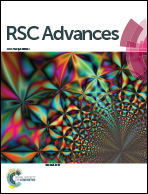Flower-like carbon with embedded silicon nano particles as an anode material for Li-ion batteries†
Abstract
A novel 3-dimensional (3D) flower-like silicon/carbon composite was synthesized through spray drying method by using NaCl as the sacrificial reagent and was evaluated as an anode material for lithium ion batteries. This composite is composed of silicon nanoparticles distributed in the flower-like carbon framework. Cycling test results showed that, serving as the anode material, the composite achieved excellent capacity values of 1323 mA h g−1 at C/20 (1C = 4200 mA g−1) after 100 cycles and 985 mA h g−1 at C/2 after 200 cycles, respectively. The enhancement of electrode stability, compared to the conventional silicon anode made of bare silicon nano particles, is attributed to the unique flower-like 3D structure of the composite, which helps to maintain the mechanical stability of the electrode, and therefore maintains better electrical contact between the anode material and the current collector.



 Please wait while we load your content...
Please wait while we load your content...